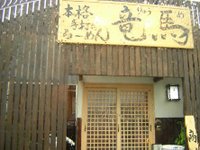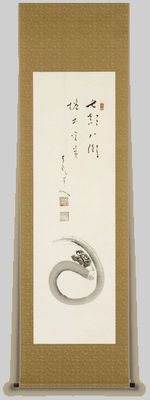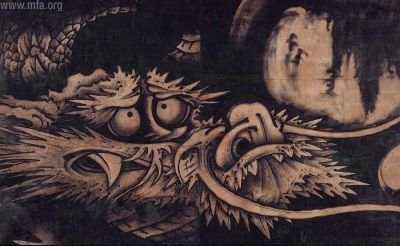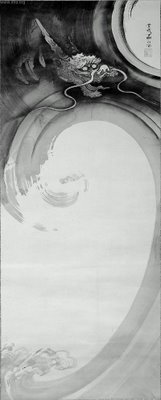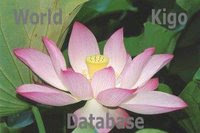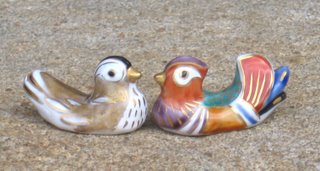[ . BACK to DARUMA MUSEUM TOP . ]
. Nichiren Shu 日蓮宗 Legends about the Nichiren Sect .
:::::::::::::::::::::::::::::::::::::::::::::::::::::::::::::::::::::::::::::::::::::::::::::::::::::
Nichiren, Saint Nichiren 日蓮
February 16, 1222 – October 13, 1282

was a Buddhist monk who lived during the Kamakura period (1185-1333) in Japan. Nichiren taught devotion to the Lotus Sutra, Namu Myōhō-Renge-Kyō, as the exclusive means to attain enlightenment and the chanting of "Nam Myo ho Renge Kyo" as the essential practice of the teaching. He is credited with founding what has come to be known as Nichiren Buddhism, a major school of Japanese Buddhism encompassing numerous sects espousing diverse doctrines.
He was
exiled to Sado Island for a while and returned to Kamakura to preach his doctrines.
He later lived on Mount Minobusan.
Nichiren Shōnin 日蓮聖人 "St. Nichiren" or "Sage Nichiren"
© More in the WIKIPEDIA !
. . . CLICK here for Photos of Mount Minobu!
身延山 Minobusan, a mountain and temple in honor of Saint Nichiren
. Goshiki suzu, goshiki rei 五色鈴 five-colored clay bells .
from Minobusan, Temple Kuon-Ji
 The Priest Nichiren in the Snow on Sado Island
. Utagawa Kuniyoshi (1797–1861) .
The Priest Nichiren in the Snow on Sado Island
. Utagawa Kuniyoshi (1797–1861) .

Nichiren is sitting in a snow-covered hut
during his exile to Sado
Tsukioka Yoshitoshi (1839-1892)
. Nichiren and Fudo Myo-O 不動明王 .
:::::::::::::::::::::::::::::::::::::::::::::::::::::::::::::::::::::::::::::::::::::::::::::::::::::
Nichiren was born in Awa Kominato 安房小湊, Chiba, now celebrated at temple
Tanjo-Ji 誕生寺 (Birth Temple)。
This is one of the most revered temples by the Nichiren sect.
Near the temple is the inlet Tae no Ura 妙の浦(たえのうら), taken from "tai no ura".
At Tae no Ura, they believe the tai sea bream is a messenger of Saint Nichiren, or even an incarnation of the Saint himself.
Sea bream is never eaten in this inlet.
. ganman no tai (gamman) 願満の鯛
sea bream after the fulfillment of a wish .
Chiba
:::::::::::::::::::::::::::::::::::::::::::::::::::::::::::::::::::::::::::::::::::::::::::::::::::::
Namu Myoho Renge Kyo 南無妙法蓮華経
 source : bosu.air-nifty.com
source : bosu.air-nifty.com
Daimoku お題目
The Nichiren Incantation to the Lotus Sutra
:::::::::::::::::::::::::::::::::::::::::::::::::::::::::::::::::::::::::::::::::::::::::::::::::::::
Nichiren and Dragon Legends
The 7 headed dragon & Kishimo Daimoku
In those days,
Kashiwazaki and Teradomari were both part of Echigo Province; Teradomari was the provincial seat, and a fairly bustling port. Kashiwazaki is to the south of Teradomari. Back then, it was a treacherous land-fall. Moreover, the area was said to be inhabited by savage barbarians, and frequented by ruthless bandits; making it an unsafe stop-over for weary, wayward travelers.
-- Nichiren, Kashiwazaki, & the Demon Storm
It is said that, upon landing at Kashiwazaski, Nichiren & the others were beset by barbaric inhabitants; as well as demonic mythical beings known as Yasha Trolls & Rasetsu Shapeshifters. Apparently, the Daishonin's saintly demeanor gave them pause. The relief on this statue depicts the event:
Nichiren learned that the rampant Yasha and Rasestsu were plaguing the local inhabitants under the direction of an evil Seven Headed Dragon. The ghastly dragon evidently resided in a cave, near the shore, at Tsunoda.
Nichiren asked to taken to the cave; whereupon he entered and subdued the dragon, by invoking the power of the benevolent Yasha Kishimo and her ten Rasetsunyo daughters. The dragon then repented, and agreed to serve as the Daimyojin for the village. The Daishonin is said to have engraved the Kishimodaimoku on a shell shaped rock, as a record of the event.
ooo ooo ooo ooo ooo ooo ooo
Legends of Nichiren: the Demon Storm
There are several 'Seven Headed Dragon' legends connected with Nichiren. One of these is related to Sado Island, Kashiwazaki, and Teradomari. The Storm Kami, the Heavenly King Bishamonten, the Yaksha Kishimojin, and Rakshasha demons, all come into play.
Up until the Edo Period, what is now Niigata Prefecture was divided into Echigo Province {the coast} and Sado Province {the Island}. After the Tatsunokuchi Incident, Nichiren was eventually taken to Teradomari, Echigo; and, from there, by boat, to Sado. His initial Sado residence was a grave yard hut at Tsukuhara. Today, that is Niibe. The following spring, he was moved to comfortable quarters at Ichinosawa, which is now Sawata.
It is said a boat carrying Nichiren encountered a demon storm, raised by Amaterasu Omikami/Tensho Daijin's mischievous lttle brother; the storm kami Susanoo, and a 7 headed dragon. Nichiren then arises, stands in the boat, raises his hand, chants the Odaimoku, and "calms the seas." There are two well known wood block prints, by Hokusai & Kuniyoshi respectively:
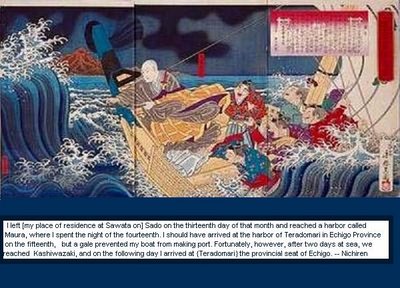 Writing an incantation on the Waves
Writing an incantation on the Waves
日蓮上人波題目
Several on line sources place this happening on the way to Sado. However, it appears that the Gosho only mentions a storm on the return trip, after the pardon. Also, local legends at Kashiwazaki are consistent with the latter.
"I left [my place of residence on] Sado on the thirteenth day of that month and reached a harbor called Maura, where I spent the night of the fourteenth. I should have arrived at the harbor of Teradomari in Echigo Province on the
fifteenth, but a gale prevented my boat from making port. Fortunately, however, after two days at sea, we reached Kashiwazaki, and on the following day I arrived at the provincial seat of Echigo."
-- Nichiren

A Vision of Prayer on the Waves
Utagawa Kuniyoshi (1797-1861)
:::::::::::::::::::::::::::::::::::::::::::::::::::::::::::::::::::::::::::::::::::::::::::::::::::::
Joeiji 常栄寺 Joei-Ji
(popularly called Botamochi-dera 牡丹餅寺)
Kamakura, Jooei-Ji 常栄寺
In 1271, the year unforgettable for the Nichiren Sect Buddhists, Priest Nichiren (1222-1282), the founder of the Nichiren sect, was sentenced to death on charges of his fierce criticism against the government policy. He had also reprimanded all other religious sects saying they were fallacious, false and even dangerous to the welfare of the country. True Buddhism is, he argued, in the Lotus Sutra and unless the government follow his suggestion, the country would continue to face natural disasters and social unrest.
Read more and some haiku about the ricecakes too !
Botamochidera Temple in Kamakura
.................................................................................
.Ryuukooji 龍口寺 Ryuko-Ji .
Tatsu no Kuchi in Fujizawa 竜の口 藤沢
Ryukoji stands on the site of the former Tatsu no Kuchi Execution Grounds, and its names uses the same two kanji. It was here that Nichiren was to have been executed in 1271. Nichiren was the only man who survived from the execution at this ground. After this event, Nichiren was banished to Sado Island for three years. Nichiren wrote many books and scrolls with the experience of Tatsukuchi.
.................................................................................
Shichimen Daimyojin is the guardian deity of Kuonji 久遠寺, the headquarters of Nichirenshu, which is in Yamanashi Prefecture.
. Shichimen Daimyojin 七面大明神 .
Shichimen Tennyo 七面天女 celestial nymph
Heavenly Lady from Mount Shichimen
Goddess Shichimen of Minobusan Kuon-ji
Shichimen Daibosatsu 七面大菩薩,
Shichimen Kannon
:::::::::::::::::::::::::::::::::::::::::::::::::::::::::::::::::::::::::::::::::::::::::::::::::::::
Ikegami Honmon-Ji 池上本門寺
1-1-1, Ikegami, Ōta-ku, Tokyo
- quote -
a temple of the Nichiren Shū south of Tokyo, erected where Nichiren is said to have died. Also Nichiren's disciple Nikkō spent the rest of his life at this temple. The temple grounds also include Nichiren Shū's administrative headquarters.
A short walk from Ikegami Station (Tōkyū Ikegami Line) or Nishi-Magome Station (Toei Asakusa Line), Ikegami Honmon-ji contains a number of buildings, most of which have been reconstructed since the bombing of 15 March 1945. They include the Important Cultural Property designated five-storey pagoda built in 1608, the kyōzō (経蔵, repository of religious writings) built in 1784, and the hōtō (宝塔), built in 1781 where Nichiren was cremated. Other buildings have been rebuilt, or newly constructed, since 1945.
Now in Ōta-ku, suburban Tokyo, Ikegami Honmon-ji was at some distance from the city until the mid-20th century. Basil Hall Chamberlain and W. B. Mason wrote of it in 1907: Its fine situation and magnificent timber make it one of the most attractive points within easy reach of Tōkyō.
The area between the station and the temple hosts a large festival, O-Eshiki (お会式), from 11 to 13 October, with mandō (万灯, an elaborate representation of a lantern stand) and matoi; thousands of worshippers visit the temple.
- - - More in the WIKIPEDIA !
- - - - -
HP of the temple - English
NICHIREN SHŌNIN AND HONMONJI TEMPLE
- source : honmonji.jp -
mantoo, mandoo 万燈 light offerings for Nichiren
 . . . CLICK here for more Photos !
. . . CLICK here for more Photos !
 fukubato, fuku hato omamori 福鳩お守り amulet with auspicious dove
fukubato, fuku hato omamori 福鳩お守り amulet with auspicious dove
This amulet is only sold from the first day of the New Year until Setsubun in February.
Once in summer there was a long period without rain in the Ikegami area and the farmers were worried about their fields and the crops. Then suddenly they saw a dove flying from Honmon-Ji to a rock and picking at it. When they dug below the rock suddenly clear water begun to flow - a new well was born. They could bring water to the fields and drink again. To show their gratefulness the temple begun to offer an amulet with this the auspicious dove.
. Tokyo and Edo Folk Art and Amulets .
br />
. Tanuma Okitsugu 田沼意次 .
encouraged the trade of white European sugar via the merchants of Nagasaki.
He also introduced the plant
satokibi , first grown at his request at a Nichiren temple, the Ikegami Honmon-Ji 池上本門寺 in the South of Edo.
From there its growth spread to other suitable areas of Japan.
:::::::::::::::::::::::::::::::::::::::::::::::::::::::::::::::::::::::::::::::::::::::::::::::::::::
H A I K U
There are variuos KIGO related to the life of this famous monk.
observance kigo for early spring
shutsugyoo-e 出行会 start of the ascetic exercises
Nichiren Sect. Feb. 10
The biggest kind of "rough ritual" aragyoo 荒行.
大荒行出行会(だいあらぎょうしゅつぎょうえ)
Selected followers of Nichiren assemble at the most important regional temples for this ascetic practise.
Throwing buckets of cold water over the naked bodies seven times a day for 100 days.
They have to chant the sutras three times a day.
They eat two meals of rice gruel with one pickled plum (umeboshi) per day.
. . . CLICK here for Photos !
.................................................................................
kigo for mid-autumn
gonan no mochi 御難の餅 (ごなんのもち)
"mochi in difficult times"
Tatsu no kuchi Hoonan E 龍口法難会(たつのくちほうなんえ)
Ceremony at the temple "Dragon Mouth"
botamochi eshiki 牡丹餅会式(ぼたもちえしき) Botamochi Ceremony
memorial service with botamochi rice cakes
. . . CLICK here for Photos !
Botamochidera Temple in Kamakura
kigo for late autumn
omeiko, Omeikō 御命講 (おめいこう) memorial service
for Saint Nichiren
. . . CLICK here for Photos !
omyookoo, o-myookoo 御命講(おみょうこう)、oeikoo, o-eikoo 御影講(おえいこう)、oeshiki, o-eshiki 御会式(おえしき)、eshiki 会式(えしき)、eshikidaiko 会式太鼓(えしきだいこ)、drums / mandoo 万燈(まんどう)lanterns
Nichirenki, Nichiren ki 日蓮忌(にちれんき)
Memorial Day for Saint Nichiren
菊鶏頭切り尽しけり御命講
kiku keitoo kiri tsukushi keri Omeikoo
chrysanthemums and cockscomb
cut in abundance -
Omeiko ceremony
 source : itoyo/basho
御命講や油のような酒五升
source : itoyo/basho
御命講や油のような酒五升
Omeikoo ya abura no yoo na sake go masu
Omeiko ceremony -
rice wine like oil
in five masu cups

元禄5年, Basho at age 49
This is a kind of sweet, strong and delicious rice wine.
It was a favorite drink of Saint Nichiren and is now still offered to him.
MORE - hokku about sake by
. Matsuo Basho 松尾芭蕉 - Archives of the WKD .
.............................................................................
 昼もなほ暗き西の谷日蓮忌
昼もなほ暗き西の谷日蓮忌
hiru mo nao kuraki Nishi no Tani Nichiren-ki
even during daytime
it is dark at "Nishi no Tani" ...
Nichiren memorial day
source : sasabune, with photo
The grave memorial is at the "West Valley" Nishi no Tani, of Mount Minobusan.
身延山・西谷
.................................................................................
kigo for mid-winter
Daikotaki, daikodaki 大根焚き
Cooking Radishes in memory Saint Nichiren
::::::::::::::::::::::::::::::::::::::::::::::::::::::::::::::::::::::::::::::::::::::::::::::::::::::::::::::::::::::::::::::::::::
full moon night -
the sound of prayer drums
from the Nichiren temple
The famous drum in form of a Chinese fan
uchiwadaiko 団扇太鼓
. Prayer Drums and Saint Nichiren .
Gabi Greve, October 2011

:::::::::::::::::::::::::::::::::::::::::::::::::::::::::::::::::::::::::::::::::::::::::::::::::::::
. Nichiren Shu 日蓮宗 Legends about the Nichiren Sect .
. Saijiki of Japanese Ceremonies and Festivals
. WASHOKU - - Food and Saint Nichiren
[ . BACK to WORLDKIGO TOP . ]
[ . BACK to DARUMA MUSEUM TOP . ]
- #nichiren #saintnichiren #nichirensect -
:::::::::::::::::::::::::::::::::::::::::::::::::::::::::::::::::::::::::::::::::::::::::::::::::::::























